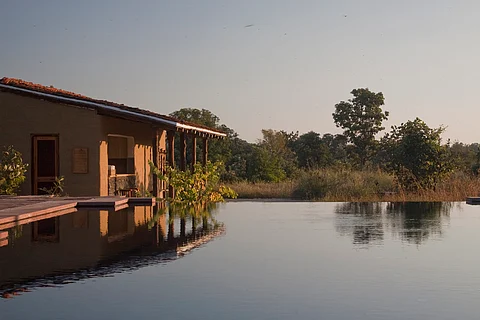

The weather is turning, and after grudgingly making our way through summer and monsoon, October is near, beckoning the start of the perfect season to spend some time in the wilderness. our favourite national parks and reserves will soon open their gates to visitors and allow us a chance to escape the din of the concrete jungle. If you&rsquod like to plan a conscious and sustainable vacation, here are a few resorts that blend wildlife tourism with sustainability and comfort.
Reni Pani Jungle Lodge, Satpura Tiger Reserve

Besides being an extension of the tiger homeland, Satpura National Park and Bori Wildlife Sanctuary that comprise the Tiger Reserve are a haven with stunning biodiversity. Not as crowded as the other Parks, spotting many of the 52 species of animals, 31 reptiles and 300 birds of which 14 are endangered, can be more accessible and breezier in these locales. Exquisitely designed, Reni Pani is a wildlife and conservation-focused lodge which is nature-infused with spot-on hospitality. At Reni Pani Jungle Lodge, the focus is on non-motorized ways of exploring the landscape and they offer walking, canoeing, cycling, and camping safaris apart from jeep and motorboat excursions to see wildlife. Their in-house expert team takes you on enthralling safaris in customised jeeps and nature walks they've also crafted some exclusive experiences of the communities around, with anthropological excursions and even horse safaris.
Diphlu River Lodge, Kaziranga National Park

A UNESCO world heritage site, Kaziranga National Park is known for being home to the world&rsquos largest population of One-horned Rhino. Bordered on the north by the Brahmaputra river and on the south by the Karbi Anglong hills, this distinct wetland also plays host to a variety of flora and fauna. For a sustainable experience, stay at Diphlu River Lodge, which has been built with natural materials like bamboo and wood and resembles a Mishing (indigenous Assamese tribe) village. The Lodge has no fencing between its premises and Kaziranga National Park, maintaining the animal corridor. They also employ locals, recycle grey water and practice composting, in addition, to supporting education, environment protection efforts and rural community development.
Kipling Camp, Kanha Tiger Reserve

Nestled in the Maikal range of Satpuras in Madhya Pradesh, Kanha Tiger Reserve, with its luxurious meadows and dense maroons of forests offers magnanimous sightseeing experiences for nature lovers. Owned by Belinda Wright, the founder of the Wildlife Protection Society of India, and established in 1982, Kipling Camp is one of the first lodges in Kanha. Less than 10% of the land has been utilized for construction and about 15 acres have been set aside as an undisturbed sanctuary for the wildlife. All the buildings have been built in the local style of architecture, connected with natural pathways. There is no fencing between the surrounding wildlife habitat and the property. Local community engagement is a key focus area for Kipling Camp with most of the staff being locals and regular support to the community for medical emergencies, school supplies and much more. The Camp has also taken initiatives to support the Baiga tribals and the local Gond artists.
The Sarai At Torai, Panna Tiger Reserve

Panna Tiger Reserve is a critical tiger habitat located in Vindhya Hill in northern Madhya Pradesh. With its mesmerizing waterfalls, naturals, archaeological splendours, legends and cultural richness, there is much to explore here. The Sarai at Toria is the vision of a husband and wife partnership - Dr Raghu Chundawat is a conservation biologist and Joanna Van Gruisen is a wildlife photographer, writer and conservationist. Their passion for wildlife and conservation translated into this boutique property situated on the west bank of the stunning Ken River. With an aim to make tourism tiger-friendly, as well as beneficial for local communities, The Sarai limits its carbon footprint by using local produce, and building materials and engages with local communities to conduct awareness studies as well.
Samode Safari Lodge, Bandhavgarh National Park

Bandhavgarh has a lot to offer to a naturalist. This land of tigers is also home to 34 species of mammals, 260 species of birds, and 70 species of butterflies. Add to this 515 varieties of trees and plants. There's history and mythology, caves with inscriptions and rock paintings, forts and statues. Inspired by the colourful vernacular architecture of the region, the decor and setting at Samode Safari Lode are distinctly Indian. The entire construction was peaceful and mindful - no trees were cut during the process. Natural features of the site remained the hero of the lodge's design. Water management is another important sustainability element - the lodge uses rainwater harvesting to recharge the groundwater table. Grey water is reused in the gardens. The building process provided employment to the locals and the lodge continues to hire staff from local villages.
